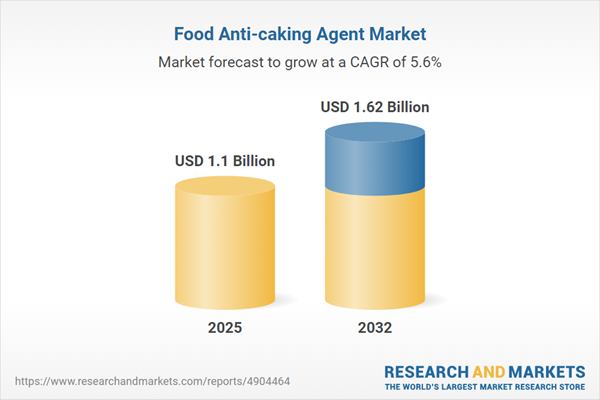Speak directly to the analyst to clarify any post sales queries you may have.
Food anti-caking agents are crucial for maintaining the quality and consistency of powdered and granular food ingredients, ensuring products remain free-flowing and easily processed across the food supply chain. As global food manufacturing evolves, innovative anti-caking solutions are rapidly shaping competitive strategies and operational resilience for industry leaders.
Market Snapshot: Food Anti-caking Agent Market Growth and Trends
The food anti-caking agent market grew from USD 1.05 billion in 2024 to USD 1.10 billion in 2025, registering a robust CAGR of 5.60% to reach USD 1.62 billion by 2032.
This expansion reflects rising demand for reliable ingredient performance, increasing consumer expectations for clean-label formulations, and a significant shift towards technological innovation and regulatory compliance within the industry.Scope & Segmentation of the Food Anti-caking Agent Market
- Type: Calcium Compounds, Cellulose, Magnesium Carbonate, Silica
- Form: Granules, Powder
- Distribution Channel: Offline Retail (Conventional Trade, Modern Trade), Online Retail
- Application: Bakery & Confectionery, Dairy & Beverages, Ready Meals, Salt & Seasonings, Soups & Sauces, Supplements
- End User: Food & Beverage Manufacturers, Food Service Operators
- Region: Americas (North America: United States, Canada, Mexico; Latin America: Brazil, Argentina, Chile, Colombia, Peru), Europe, Middle East & Africa (Europe: United Kingdom, Germany, France, Russia, Italy, Spain, Netherlands, Sweden, Poland, Switzerland; Middle East: United Arab Emirates, Saudi Arabia, Qatar, Turkey, Israel; Africa: South Africa, Nigeria, Egypt, Kenya), Asia-Pacific (China, India, Japan, Australia, South Korea, Indonesia, Thailand, Malaysia, Singapore, Taiwan)
- Leading Companies: Agropur Dairy Cooperative, Archer-Daniels-Midland Company, BASF SE, Batory Foods, Bimal Pharma Pvt. Ltd., Brenntag SE, Cabot Corporation, Evonik Industries AG, Hydrite Chemical Co., JELU-WERK J. Ehrler GmbH & Co. KG, Merck KGaA, Omya International AG, PPG Industries, Inc., PQ Corporation, RIBUS Inc.
Key Takeaways: Strategic Insights for Decision-makers
- Innovative encapsulation technologies are enhancing moisture resistance and reducing additive volumes, directly impacting product development and operational cost structures.
- Plant-derived and cleaner-label anti-caking alternatives are gaining momentum due to consumer demand and evolving regulations in major global markets.
- Digital traceability and real-time quality monitoring are transforming ingredient assurance, allowing stakeholders to track provenance and consistency across multiple production sites.
- Collaborative R&D partnerships and intelligent packaging pilots are accelerating time-to-market and unlocking region-specific product adaptations.
- Supply chain adaptations, including production expansion outside traditional regions and nearshoring, support resilience for manufacturers facing tariff-driven disruptions.
Tariff Impact: Navigating Regulatory Challenges
Recent US tariff measures have led to higher landed costs for anti-caking agents and raw materials. In response, producers are diversifying sourcing, optimizing inventory strategies, and investing in offshore manufacturing to mitigate trade risks. Long-term supplier agreements and regional expansion are becoming essential for supply stability and compliance.
Methodology & Data Sources
The primary keyword, food anti-caking agent market, anchors this report’s robust analytical methodology. Insights were gathered through expert interviews with R&D, procurement, and quality assurance leaders, complemented by secondary research from regulatory sources, trade publications, and industry data. Stringent triangulation and peer review processes ensure the accuracy and credibility of these findings.
Why This Report Matters for Industry Leaders
- Equips decision-makers with actionable intelligence for ingredient selection, sourcing, and sustainable product innovation.
- Clarifies competitive and regulatory changes, highlighting how new technologies and partnerships shape the global anti-caking sector.
- Supports risk mitigation through detailed segmentation, regional trends, and supply chain strategies.
Conclusion: Market Outlook and Strategic Opportunities
The anti-caking agent sector is evolving rapidly with an increased focus on sustainability, digital quality controls, and regional adaptation. Strategic investment, collaboration, and proactive supply management are imperative for sustaining growth, ensuring compliance, and capturing emerging opportunities in the global market.
Additional Product Information:
- Purchase of this report includes 1 year online access with quarterly updates.
- This report can be updated on request. Please contact our Customer Experience team using the Ask a Question widget on our website.
Table of Contents
3. Executive Summary
4. Market Overview
7. Cumulative Impact of Artificial Intelligence 2025
Companies Mentioned
The companies profiled in this Food Anti-caking Agent market report include:- Agropur Dairy Cooperative
- Archer-Daniels-Midland Company
- BASF SE
- Batory Foods
- Bimal Pharma Pvt. Ltd.
- Brenntag SE
- Cabot Corporation
- Evonik Industries AG
- Hydrite Chemical Co.
- JELU-WERK J. Ehrler GmbH & Co. KG
- Merck KGaA
- Omya International AG
- PPG Industries, Inc.
- PQ Corporation
- RIBUS Inc.
Table Information
| Report Attribute | Details |
|---|---|
| No. of Pages | 184 |
| Published | November 2025 |
| Forecast Period | 2025 - 2032 |
| Estimated Market Value ( USD | $ 1.1 Billion |
| Forecasted Market Value ( USD | $ 1.62 Billion |
| Compound Annual Growth Rate | 5.6% |
| Regions Covered | Global |
| No. of Companies Mentioned | 16 |









